Overview
This article highlights ten exceptional books on autism, specifically chosen to empower parents on their journey of understanding and supporting their children. Each book offers unique insights, practical strategies, or personal narratives that foster empathy and enhance communication between parents and their autistic children. By exploring these resources, parents can cultivate a more inclusive and supportive environment for their families. We invite you to discover these valuable tools that not only inform but also inspire a deeper connection and understanding.
Introduction
In a world where autism is increasingly recognized yet often misunderstood, a wealth of resources exists to empower parents and caregivers. These resources range from groundbreaking literature that delves into the intricacies of autism to practical guides that foster empathy and connection, offering invaluable insights.
Books like:
- "The Reason I Jump"
- "NeuroTribes"
- "The Autism Acceptance Book"
- "Different…Not Less"
challenge traditional narratives, while celebrating the unique strengths of autistic individuals.
This article explores a curated selection of essential readings that illuminate the diverse experiences within the autism spectrum and equip parents with the tools they need to advocate effectively for their children. By engaging with these narratives and insights, families can foster a deeper understanding and create a more inclusive environment for all.
About ASD Media: Empowering Parents with Autism Resources
At ASD Media, we are committed to enhancing the application of ABA therapy, providing essential insights and strategies that empower caregivers and professionals to navigate challenges and improve outcomes. Our organization offers a wide array of resources designed to support individuals in the field, creating a nurturing community where experiences can be shared and learning is encouraged. By subscribing to our newsletter, you will gain access to the latest news and unlimited digital resources tailored to your needs.
Our mission at ASD Media is to empower caregivers and professionals to unlock the potential of children with autism and ADHD. We achieve this through effective strategies for managing challenging behaviors, navigating support services, and fostering social skills development. Recent studies indicate that individuals aged six and older benefit significantly from ongoing skill development and social integration through ABA therapy. This highlights the critical role of community support for caregivers.
Furthermore, case studies reveal that intensive and long-term ABA therapy can lead to remarkable improvements in various skills, such as intellectual functioning, language development, and daily living skills. For example, one study showcased a girl's reading comprehension surpassing that of her brother and peers, illustrating the positive outcomes linked to effective ABA strategies. ASD Media is at the forefront of these advancements, providing expert insights and materials that reflect the latest trends in ABA therapy for 2025. We ensure caregivers are well-equipped to implement effective strategies within their family environments. As Steven Zauderer, CEO & Founder, emphasizes, "BACB Certificant Data ABA Therapy Statistics illustrate the important role of continuous evaluation and oversight in establishing the ideal duration of therapy for individuals with developmental disorders." This statement underscores the necessity of tailored approaches in ABA therapy and further highlights the importance of community support for parents.
The Reason I Jump: Insights from a Thirteen-Year-Old Boy with Autism
The Reason I Jump,' authored by Naoki Higashida, offers profound reflections from the perspective of a thirteen-year-old boy with a developmental disorder. Through a unique question-and-answer format, Higashida shares his thoughts and feelings, illuminating the often-overlooked challenges of nonverbal communication. This book is among the best books on autism, serving as an invaluable resource for caregivers by fostering understanding and compassion—qualities essential for nurturing connections with their children.
Notably, data revealing that 1 in 6 children aged 3–17 were identified with a developmental disability between 2009 and 2017 underscores the prevalence of such conditions, making these insights crucial for those caring for these children. Higashida’s analogy comparing communication for someone with a developmental disorder to speaking a foreign language effectively captures the anxiety and misunderstandings that can arise, as explored in the case study 'Communication Challenges in Autism.' This analogy calls for increased awareness and support.
By engaging with 'The Reason I Jump,' which is considered one of the best books on autism, parents can uncover valuable insights that enhance their ability to connect with their children, ultimately fostering positive development for nonverbal autistic individuals. As Higashida beautifully expresses, 'Life is like a puzzle - uniquely challenging but ultimately rewarding,' inviting us to celebrate individuality and diversity. This makes the book one of the best books on autism for anyone looking to deepen their understanding of developmental disorders and strengthen their bonds with their children.
NeuroTribes: The Legacy of Autism and the Future of Neurodiversity
NeuroTribes' by Steve Silberman stands as a pivotal work that delves into the history of neurodevelopmental disorders and the emergence of the neurodiversity movement. By challenging conventional views, it champions a more inclusive understanding of autistic individuals, inviting parents to explore the broader implications of autism. This book is among the best books on autism for those seeking to grasp the nuances of neurodiversity and its role in advocacy.
As Dr. Stephen Shore highlights, recognizing the unique individuality of people with autism is crucial for providing effective support. Recent studies underscore the urgent need for awareness, revealing that autistic individuals are at a significantly higher risk of experiencing comorbid conditions such as anxiety and ADHD, as well as facing increased risks of bullying and suicidal thoughts—autistic individuals are twice as likely to report suicidal thoughts compared to their non-autistic peers.
Furthermore, research indicates that the prevalence of Autism Spectrum Disorder (ASD) is notably higher among Hispanic and non-Hispanic Black youth, emphasizing the critical need for inclusive advocacy efforts. As we look towards 2025, the neurodiversity movement continues to flourish, with advocacy inspired by 'NeuroTribes' nurturing a more accepting society.
Silberman's insights serve as a poignant reminder that understanding the history of developmental disorders is not just an academic pursuit; it is one of the best books on autism for caregivers striving to advocate for their children, empowering them to navigate the complexities of support services with confidence and compassion.
The Autistic Brain: Thinking Across the Spectrum by Temple Grandin
The Autistic Brain' by Temple Grandin beautifully weaves her personal experiences with scientific insights, offering a profound exploration of the unique functioning of autistic brains. This book is among the best books on autism, serving as an essential resource for caregivers and deepening their understanding of the cognitive differences that characterize individuals on the spectrum. Grandin highlights visual cognition and sensory processing, equipping caregivers with the knowledge needed to navigate the complexities of developmental disorders effectively.
By recognizing these distinct cognitive profiles, parents can provide better support for their children and implement strategies that foster their growth and well-being. As George Sachs, PsyD, notes, 'By comprehending the link between SPD and the condition on the autism spectrum, we can refer to the best books on autism to more effectively support and advocate for individuals with these conditions.' This perspective underscores the importance of acknowledging sensory processing challenges in children with developmental disorders.
Furthermore, incorporating sensory diets—personalized plans that include specific activities to help regulate sensory input—can enhance sensory regulation and overall well-being. The findings from the ADDM Network further emphasize the necessity for public health measures regarding these conditions, highlighting the importance of understanding them. Additionally, severity scores, which range from 1 to 10 based on the total raw score from the administered module, provide a data-driven perspective that can assist caregivers in grasping the varying degrees of the condition and adjusting their support accordingly.
Uniquely Human: A Different Way of Seeing Autism by Barry M. Prizant
Uniquely Human' by Barry M. Prizant is considered one of the best books on autism, as it offers a transformative perspective that highlights the inherent strengths and unique qualities of autistic individuals. This book encourages guardians to embrace their children's differences, fostering a supportive atmosphere that celebrates uniqueness. It provides practical strategies for enhancing communication and connection, such as utilizing visual supports and engaging in shared interests, which are essential for effective interaction within family settings.
Importantly, research shows that autistic individuals often excel in areas like pattern recognition and detail-oriented tasks, revealing their potential across various environments. However, it is crucial to acknowledge the educational challenges they face; statistics indicate that 8% of autistic students in the U.S. do not complete high school, compared to 5% of all students. In contrast, 74% of autistic students graduate with a diploma, emphasizing the significance of the supportive strategies outlined in 'Uniquely Human.'
By focusing on these strengths while recognizing the challenges, caregivers can cultivate a positive environment that nurtures growth and understanding. This book is considered one of the best books on autism and serves as a vital resource for anyone looking to create a nurturing and uplifting atmosphere for their children, making it essential for guardians navigating the complexities of developmental differences with compassion and understanding.
Look Me in the Eye: My Life with Asperger's by John Elder Robison
Look Me in the Eye' by John Elder Robison offers a profound glimpse into the author's life with Asperger's syndrome. Through his candid and often humorous narrative, Robison illuminates the unique challenges faced by individuals on the spectrum, from childhood misunderstandings to the complexities of social interactions. His experiences resonate deeply, providing caregivers with a relatable viewpoint that nurtures empathy and understanding. This memoir is considered one of the best books on autism, serving not only as an enjoyable read but also as a crucial resource for caregivers seeking to comprehend their children's experiences and navigate the complexities of autism.
Robison's journey of self-acceptance, marked by moments of rejection and triumph, highlights the importance of embracing differences. This ultimately guides readers toward a more compassionate approach in supporting their children. As caregivers delve into this memoir, they gain valuable insights that can significantly influence their perceptions of Asperger's syndrome, enhancing their ability to advocate effectively for their children.
As Robison himself notes, he is 'very attentive and present with Cubby,' showcasing his playful nature as a father. Additionally, the case study titled 'John's Journey of Self-Acceptance' emphasizes how embracing one's differences can lead to peace and fulfillment. Furthermore, statistics reveal that many individuals with Asperger's syndrome encounter considerable challenges in social settings, underscoring the necessity for understanding and support. By weaving together these elements, the memoir transforms into one of the best books on autism, providing a more impactful resource for guardians aiming to empower themselves and their children.
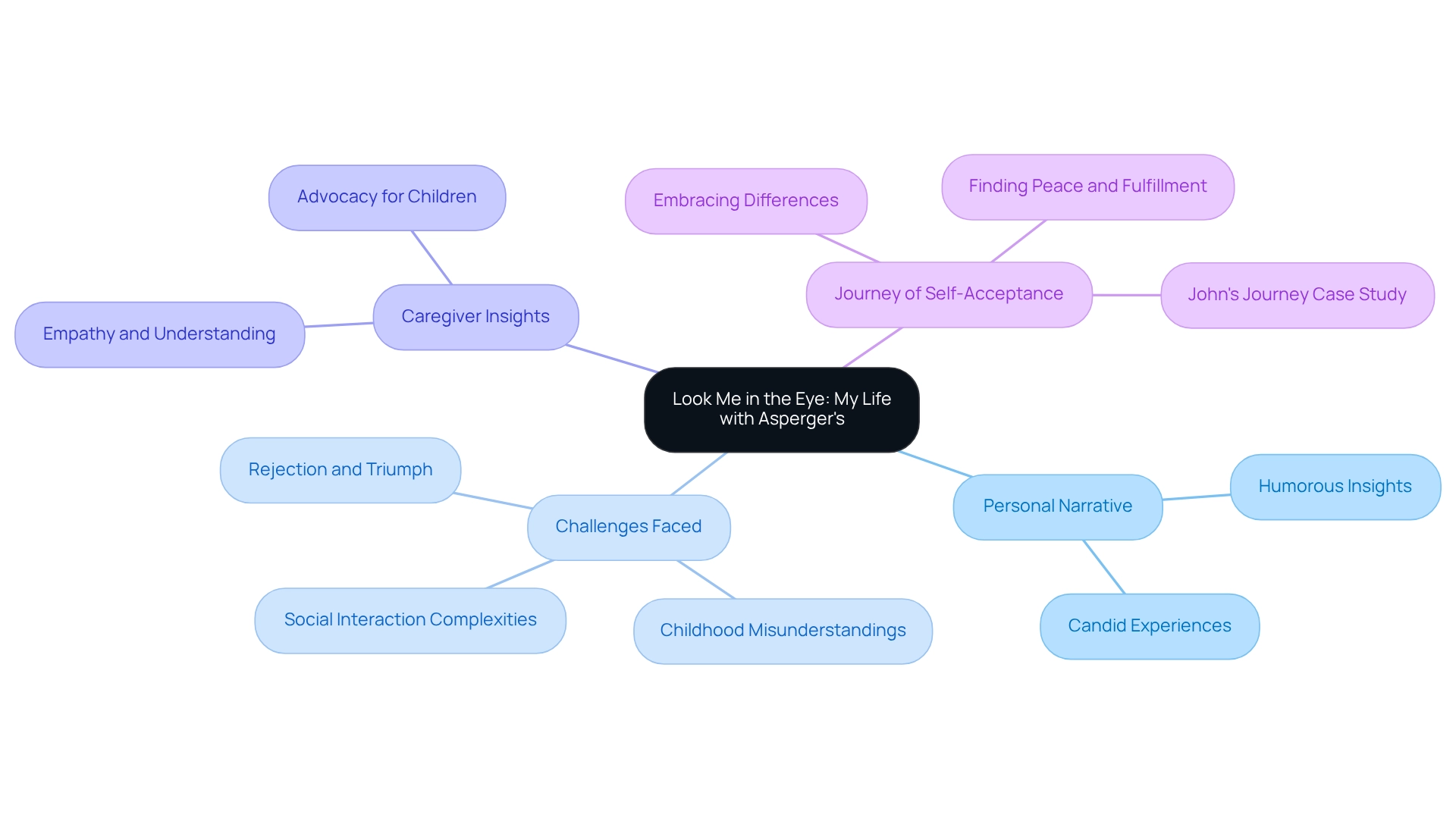
The Autism Acceptance Book: Being a Friend to Someone with Autism by Ellen Sabin
The Autism Acceptance Book' by Ellen Sabin serves as a precious interactive tool designed to enlighten young minds about developmental disorders and nurture supportive friendships. By cultivating empathy and understanding, this book, regarded as one of the best books on autism, equips parents with essential resources to help their children forge meaningful connections with peers on the spectrum. Its engaging interactive elements not only captivate young readers but also instill a sense of community and acceptance from a tender age.
With Arizona's site-specific prevalence of Autism Spectrum Disorder at 26.8 per 1,000, resources like this book are vital in addressing the needs of youth with the condition. As highlighted by Williams AR, early education about autism is crucial, especially as the early identification of ASD continues to improve. This underscores the importance of 'The Autism Acceptance Book' as one of the best books on autism in shaping young people's perceptions and interactions, ultimately fostering a more inclusive society.
Furthermore, ongoing advancements in early detection initiatives accentuate the timely relevance of this resource in educating children and promoting acceptance in a world that is increasingly becoming aware of autism.
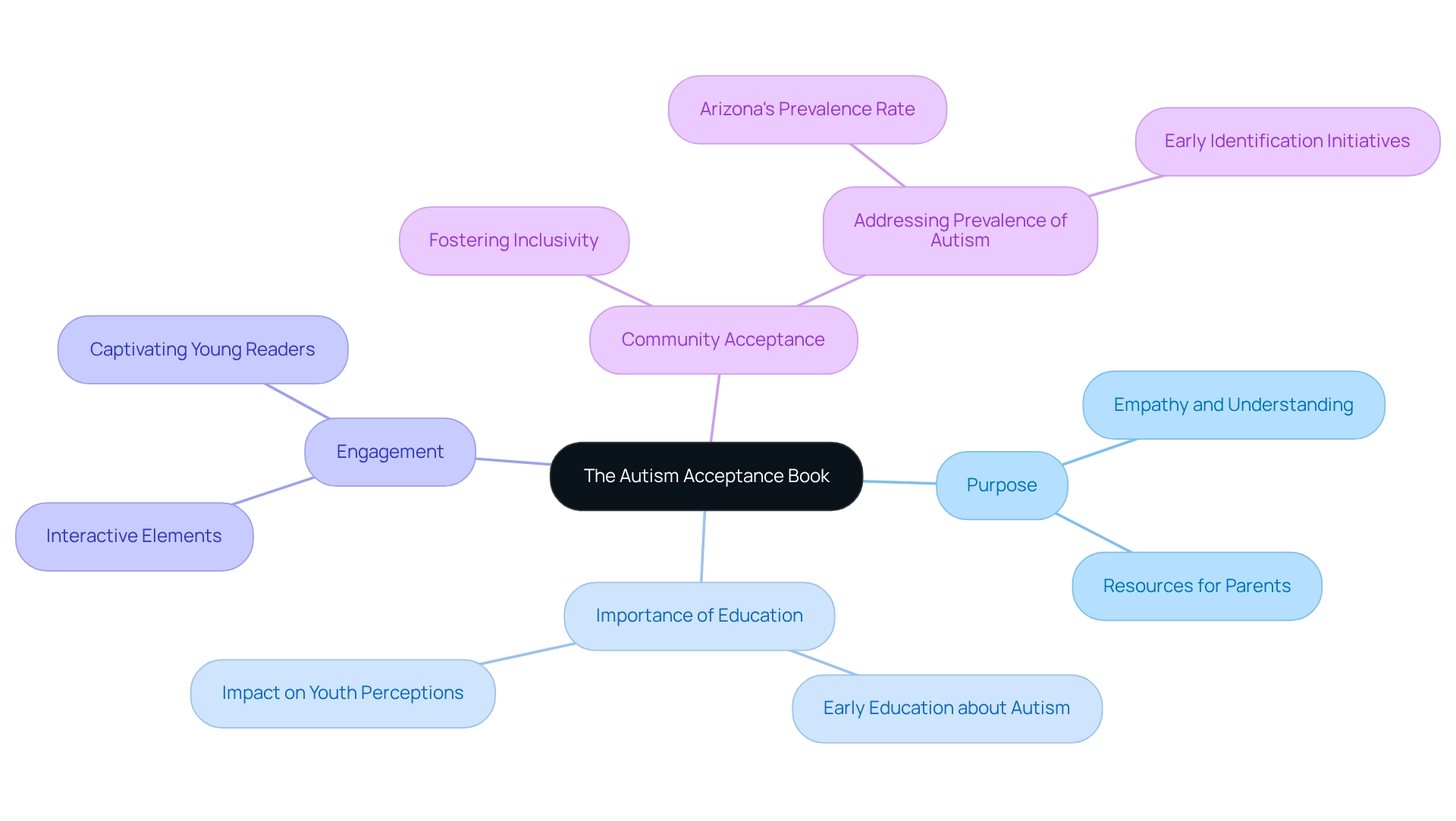
Different…Not Less: Inspiring Stories of Achievement from Adults with Autism by Temple Grandin
Different…Not Less' by Temple Grandin presents a compelling collection of inspiring stories from adults on the spectrum, emphasizing their remarkable achievements and contributions to society. This anthology is among the best books on autism, serving as a beacon of hope and motivation for parents, illustrating that autism often comes with unique strengths and capabilities. Grandin's work encourages families to embrace and celebrate their children's individuality, reinforcing the idea that every autistic individual has the potential to excel in various fields. The narratives within this book not only highlight personal triumphs but also underscore the importance of recognizing and nurturing the talents of autistic individuals.
As the prevalence of autism continues to rise—evidenced by a staggering increase of over 700% in South Africa since 2000, with data collected specifically for 8-year-olds—the stories in 'Different…Not Less' become crucial in fostering understanding and acceptance. The last update on this data was in April 2023, emphasizing the ongoing relevance of these discussions. By sharing these accomplishments, the book motivates caregivers to assist their children in overcoming obstacles while appreciating their distinct abilities, ultimately improving their overall wellness and potential, and it also serves as one of the best books on autism that encourages parents to actively acknowledge their children's strengths and seek resources that address common challenges, such as sensory sensitivities. Creating a supportive environment is essential for fostering their development.
How can you celebrate your child's unique abilities today? Consider exploring local resources or connecting with other families to share experiences and support each other on this journey.
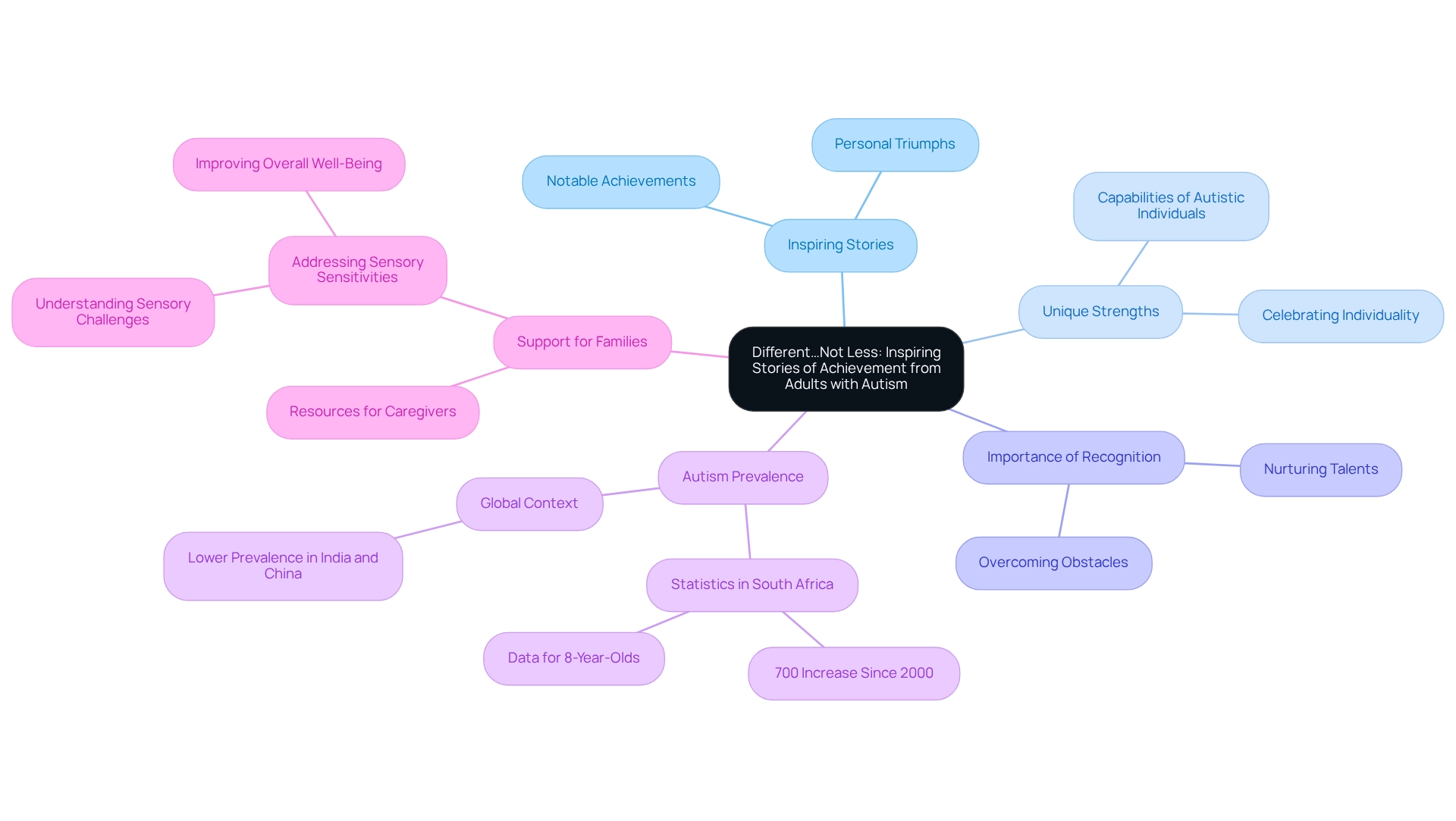
Camouflage: The Hidden Lives of Autistic Women by Sarah Bargiela
Camouflage' by Sarah Bargiela is considered one of the best books on autism, as it is a remarkable graphic novel that explores the intricate experiences of autistic women and sheds light on the societal challenges they face. This work is vital for guardians seeking to understand the unique challenges related to the spectrum, as it showcases some of the best books on autism to foster a deeper awareness of its diversity. Through engaging illustrations and narratives, 'Camouflage' not only brings to light the struggles of autistic women but also underscores the significance of empathy and awareness in supporting their journeys.
By delving into themes such as social expectations and the pressure to conform, the book inspires a more inclusive perspective that can empower parents to advocate effectively for their children. Furthermore, understanding trends in the prevalence of the condition and the age of diagnosis, as highlighted in recent studies, provides valuable insights for families affected by the disorder.
The test-retest reliability for the STAIC-Trait, ranging from 0.65 to 0.71, suggests that good memory may help individuals with developmental disorders in recognizing emotions, even if they do not fully comprehend them. Additionally, the Contextual Assessment of Social Skills (CASS) has proven effective in evaluating various aspects of social skills in young individuals with ASD, emphasizing the practical implications of acknowledging gender-specific issues related to the condition.
Recent findings from the Interactive Drawing Task (IDT) reveal that girls on the autism spectrum exhibited higher reciprocity scores, highlighting the importance of social reciprocity in understanding their experiences. By weaving these insights together, 'Camouflage' evolves into not just a narrative but one of the best books on autism, providing an essential resource for guardians advocating for their children in a complex social landscape.
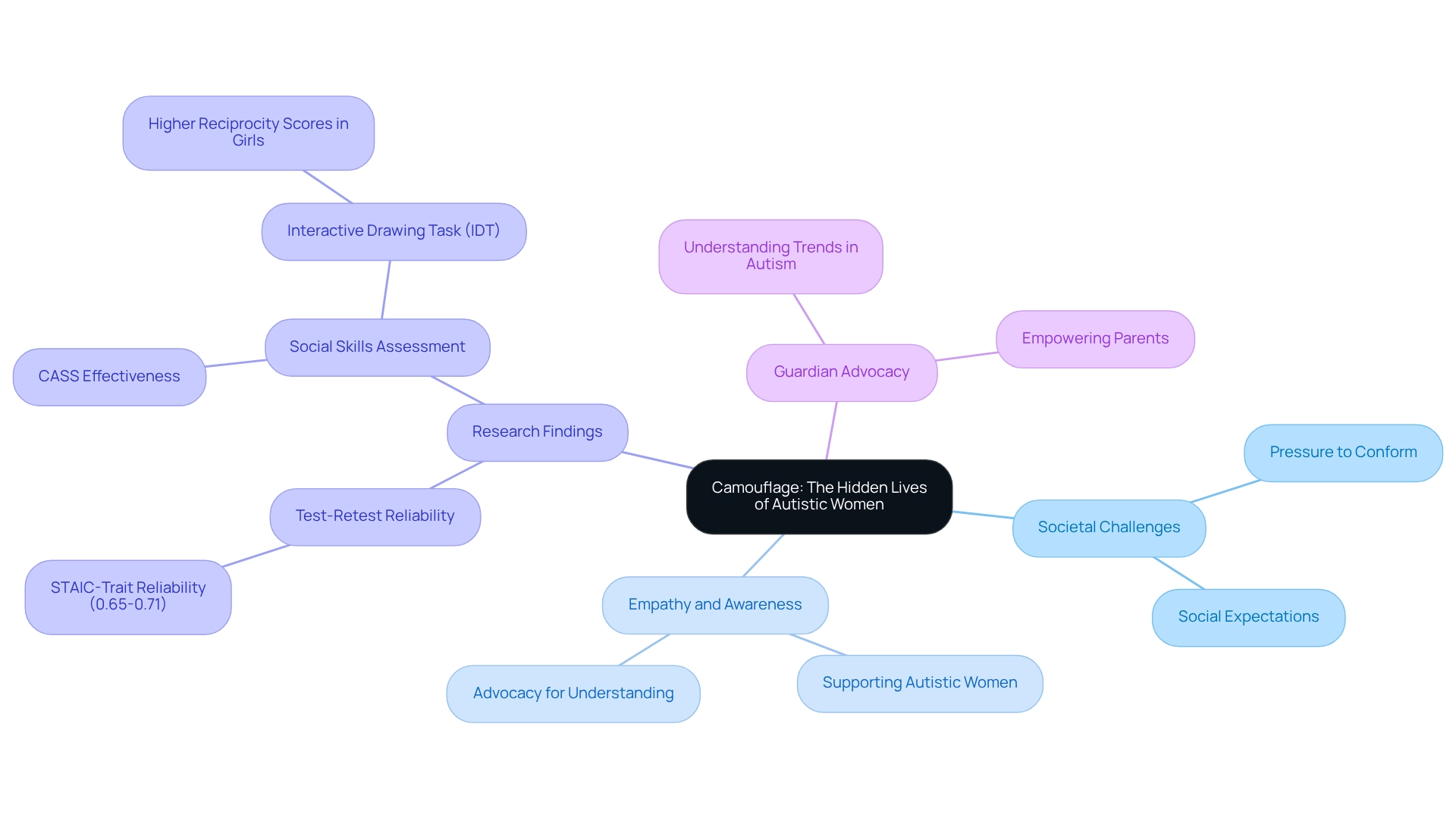
Sincerely, Your Autistic Child: An Anthology by Autistic Individuals
Sincerely, Your Autistic Child' is a pivotal anthology that unites the authentic voices of autistic individuals, offering invaluable insights into their lived experiences. This collection serves as a vital resource for caregivers who wish to understand their children's unique perspectives and navigate the complexities of autism.
By highlighting the importance of open dialogue, the anthology encourages caregivers to engage in meaningful discussions with their autistic children, fostering deeper connections and mutual understanding. The stories within this book illuminate not only the challenges faced by autistic individuals but also celebrate their strengths, enabling caregivers to support their children more effectively.
Research indicates that parental involvement in understanding the viewpoints of autistic individuals is crucial for enhancing awareness and improving outcomes. The Centers for Disease Control and Prevention even notes that 50% of all autistic adults live with a family member, underscoring the significance of this engagement.
Moreover, with developmental disorders affecting Pacific Islander youth at a rate of 3.33%, it is essential for guardians to appreciate the diverse experiences within the autistic community. The anthology also addresses racial disparities in autism diagnosis, emphasizing the need to understand varied perspectives.
To apply the insights from this anthology, caregivers are encouraged to initiate open dialogues with their children, creating a safe space for sharing thoughts and feelings. This makes 'Sincerely, Your Autistic Child' one of the best books on autism that every parent should include in their library.
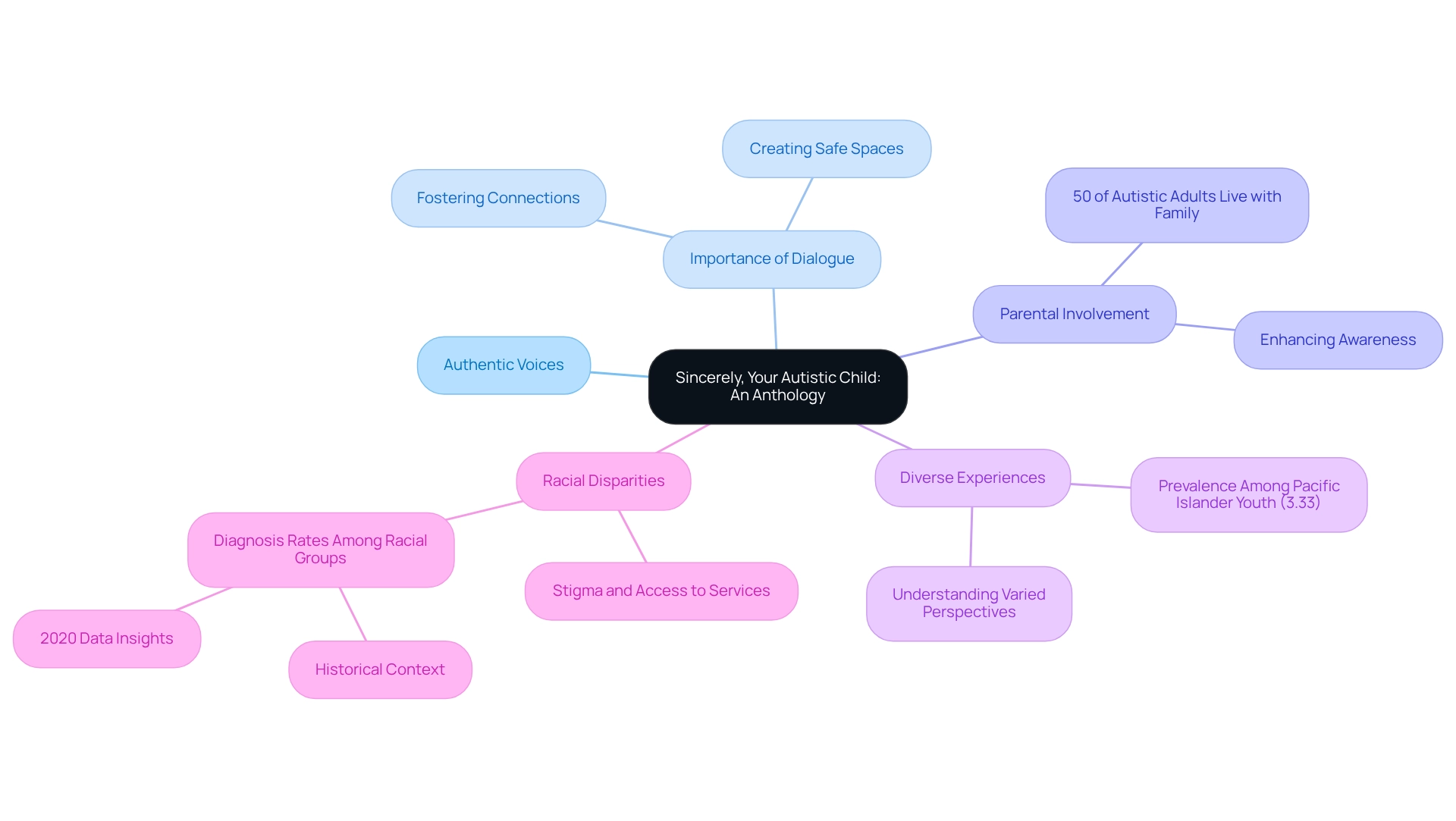
Conclusion
Engaging with the wealth of literature available on autism empowers parents and caregivers to navigate the complexities of supporting their children effectively. Each book discussed, from "The Reason I Jump" to "Sincerely, Your Autistic Child," offers unique insights that foster understanding and acceptance. These narratives illuminate the diverse experiences within the autism spectrum while providing practical strategies for enhancing communication and connection.
The importance of empathy and advocacy cannot be overstated. As families immerse themselves in these readings, they gain the tools necessary to create a supportive environment that celebrates individuality and nurtures growth. Understanding the historical context of autism and the neurodiversity movement, as presented in "NeuroTribes," equips parents to advocate confidently for their children’s needs and rights, ensuring they receive the support they deserve.
Ultimately, the journey of understanding autism is ongoing, and each story shared contributes to a broader narrative of acceptance and empowerment. By embracing the strengths and challenges highlighted in these essential readings, parents can foster a more inclusive society where every autistic individual is valued for their unique contributions. The collective insights from these books serve as a beacon of hope, inspiring families to navigate the path of autism with compassion, resilience, and unwavering support.
Frequently Asked Questions
What is the mission of ASD Media?
The mission of ASD Media is to empower caregivers and professionals to unlock the potential of children with autism and ADHD through effective strategies for managing challenging behaviors, navigating support services, and fostering social skills development.
How does ASD Media support caregivers and professionals?
ASD Media provides a wide array of resources designed to support individuals in the field, creating a nurturing community for sharing experiences and encouraging learning. By subscribing to their newsletter, users gain access to the latest news and unlimited digital resources tailored to their needs.
What evidence supports the effectiveness of ABA therapy for individuals with autism and ADHD?
Recent studies indicate that individuals aged six and older benefit significantly from ongoing skill development and social integration through ABA therapy. Intensive and long-term ABA therapy has been shown to lead to remarkable improvements in skills such as intellectual functioning, language development, and daily living skills.
Can you provide an example of positive outcomes from ABA therapy?
One study showcased a girl whose reading comprehension surpassed that of her brother and peers, illustrating the positive outcomes linked to effective ABA strategies.
What does Steven Zauderer emphasize about ABA therapy?
Steven Zauderer, CEO & Founder of ASD Media, emphasizes the importance of continuous evaluation and oversight in establishing the ideal duration of therapy for individuals with developmental disorders, highlighting the necessity of tailored approaches in ABA therapy.
What insights does "The Reason I Jump" offer to caregivers?
"The Reason I Jump," authored by Naoki Higashida, shares profound reflections from a thirteen-year-old boy with a developmental disorder, illuminating the challenges of nonverbal communication. It serves as a valuable resource for caregivers, fostering understanding and compassion to enhance connections with their children.
What does the data reveal about the prevalence of developmental disabilities in children?
Data shows that 1 in 6 children aged 3–17 were identified with a developmental disability between 2009 and 2017, emphasizing the importance of insights for those caring for these children.
How does "NeuroTribes" contribute to the understanding of autism?
"NeuroTribes" by Steve Silberman delves into the history of neurodevelopmental disorders and the neurodiversity movement, challenging conventional views and advocating for a more inclusive understanding of autistic individuals. It serves as a key resource for caregivers seeking to navigate support services confidently.
What are the risks faced by autistic individuals, as highlighted in recent studies?
Recent studies indicate that autistic individuals are at a higher risk of experiencing comorbid conditions such as anxiety and ADHD, as well as facing increased risks of bullying and suicidal thoughts—autistic individuals are twice as likely to report suicidal thoughts compared to their non-autistic peers.
Why is understanding the history of developmental disorders important for caregivers?
Understanding the history of developmental disorders is crucial for caregivers as it empowers them to advocate for their children effectively and navigate the complexities of support services with confidence and compassion.




